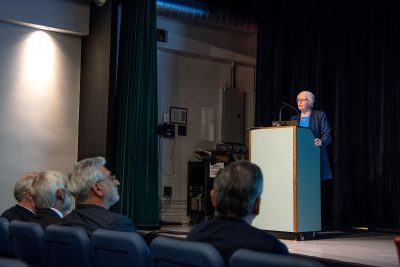
Boston University invited students, alumni and local community members to a town hall meeting Tuesday regarding the construction of the new Center for Computing Sciences building on Commonwealth Avenue.
Construction for the Center for Computing Sciences is slated to begin March 2020, according to a schedule shown at the meeting. The building will be 19 stories and it will take up 345,000 square feet.
The project will go through several stages of excavation and foundational work before the building is scheduled to be completed in the fall of 2022.
Jean Morrison, university provost and chief academic officer, led the town hall meeting held in the George Sherman Union auditorium with the goal of informing attendees about the project.
“[The building] is going to be a game-changer for [Boston University] in the growing field of computational sciences and the faculty of computing and data sciences,” Morrison said.
Morrison said that BU is essentially responding to student demand. One of the goals of the Center for Computing Sciences is to keep the courses updated so students are able to be properly educated while also gaining experience in their field.
“Everybody knows the world is more interconnected and data-driven than ever before,” Morrison said. “And the demand from our students for relevant courses and majors and opportunities for ways to be educated and gain experience in the whole array of areas that are broadly under the umbrella of data science has been growing at an extraordinary rate over the last five years.”
The university believes that the new building will place BU among the top competitors in the data and sciences computing field. The building will enhance interconnected research, make room for new faculty and be a transformative and sustainable design.
KPMB Architects, the firm commissioned with the project, have ensured their design is conducive to its surroundings.
Luigi LaRocca, the founding principal at KPMB Architects, has been leading project management since KPMB was founded. At the event, LaRocca emphasized the importance of focusing on the ground experience of the building.
“For us, when you’re making a building in the city, it’s an act of civic building,” LaRocca said. “It’s really important to concentrate on the experience on the ground.”
BU, along with the architects, plans to transform the streetscape with tables and greenery as well as create a bike shelter for sixty to ninety bicycles, LaRocca said.
The building also has numerous sustainability initiatives. The building will have a resilient design while also being energy efficient, according to BU.
The plans are for the building to be fossil fuel and carbon free while having a strong indoor environmental quality. BU aims for the new building to become a key feature in climate leadership.
Dennis Carlberg, the associate vice president for university sustainability, said in an interview the environmentally friendly component of the Center for Computing Sciences is important for BU’s sustainability goals.
“We have a commitment to get to carbon neutral by 2040,” Carlberg said. “And this building embodies that commitment.”
Carlberg also said the innovation of this building will allow it to become the largest carbon free building in the area.
“This is impressive stuff. This is the biggest carbon free Boston building in Boston,” Carlberg said. “This is significant. This is leadership. This is Boston University stepping up to lead in this area.”
Professor in the Department of Earth and Environment Nathan Phillips shared similar sentiments on what this building means for the community.
“I don’t know if I’ve ever felt more proud to be at BU,” Phillips said.
A recurring concern of many of the town hall attendants was about the new building’s disruption to the area. There were worries about the construction noise, the effect of wind, and the 7 a.m. to 6 p.m. weekday construction hours.
“I’m willing to tolerate [the noises and vibrations] because of what I know the building is going to be and I’ll work around that as I can,” Phillips said.
In the presentation, the university included diagrams of the month-by-month construction schedule and the intensity of the vibrations people will feel on different parts of campus.
Boston University plans to continue to provide as much transparency as possible on this project. The building will have a page on the BU Facilities website with live camera feed, biweekly schedule updates, and project notifications.
Thomas Silver, a freshman in the College of Arts and Sciences, said he thinks the forum was helpful.
“I thought it was informative,” Silver said. “I thought they didn’t sugarcoat [the disruptions of the building].”


You cannot under-estimate the collateral, beneficial effect this project will have on BU writ large. High School students who are incredibly impressionable at 16,17,18 years of age, will arrive at Admissions and be mesmerized by the beauty and grandeur of the center right in front of them. Trust me, I am also a graduate of Columbia and the expressions on students faces when they walk through the gates at 116th and Amsterdam are precious. They are incredulous at the beauty of the place. The bottom line is that you get one chance to make a first impression ! Applications and selectivity will both go up. The Alumni Castle is also directly across the street. Alumni will be bursting with pride when they return for reunions. Their giving should increase considerably. Kudos to all who made this happen. We’re on a roll!